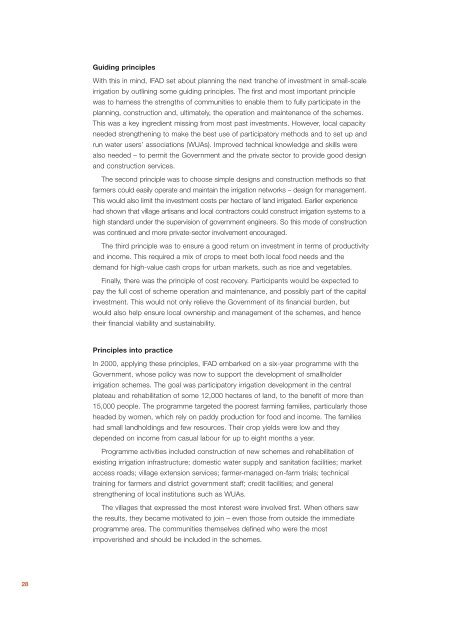Community-based natural resource management - International ...
Community-based natural resource management - International ...
Community-based natural resource management - International ...
Create successful ePaper yourself
Turn your PDF publications into a flip-book with our unique Google optimized e-Paper software.
28<br />
Guiding principles<br />
With this in mind, IFAD set about planning the next tranche of investment in small-scale<br />
irrigation by outlining some guiding principles. The first and most important principle<br />
was to harness the strengths of communities to enable them to fully participate in the<br />
planning, construction and, ultimately, the operation and maintenance of the schemes.<br />
This was a key ingredient missing from most past investments. However, local capacity<br />
needed strengthening to make the best use of participatory methods and to set up and<br />
run water users’ associations (WUAs). Improved technical knowledge and skills were<br />
also needed – to permit the Government and the private sector to provide good design<br />
and construction services.<br />
The second principle was to choose simple designs and construction methods so that<br />
farmers could easily operate and maintain the irrigation networks – design for <strong>management</strong>.<br />
This would also limit the investment costs per hectare of land irrigated. Earlier experience<br />
had shown that village artisans and local contractors could construct irrigation systems to a<br />
high standard under the supervision of government engineers. So this mode of construction<br />
was continued and more private-sector involvement encouraged.<br />
The third principle was to ensure a good return on investment in terms of productivity<br />
and income. This required a mix of crops to meet both local food needs and the<br />
demand for high-value cash crops for urban markets, such as rice and vegetables.<br />
Finally, there was the principle of cost recovery. Participants would be expected to<br />
pay the full cost of scheme operation and maintenance, and possibly part of the capital<br />
investment. This would not only relieve the Government of its financial burden, but<br />
would also help ensure local ownership and <strong>management</strong> of the schemes, and hence<br />
their financial viability and sustainability.<br />
Principles into practice<br />
In 2000, applying these principles, IFAD embarked on a six-year programme with the<br />
Government, whose policy was now to support the development of smallholder<br />
irrigation schemes. The goal was participatory irrigation development in the central<br />
plateau and rehabilitation of some 12,000 hectares of land, to the benefit of more than<br />
15,000 people. The programme targeted the poorest farming families, particularly those<br />
headed by women, which rely on paddy production for food and income. The families<br />
had small landholdings and few <strong>resource</strong>s. Their crop yields were low and they<br />
depended on income from casual labour for up to eight months a year.<br />
Programme activities included construction of new schemes and rehabilitation of<br />
existing irrigation infrastructure; domestic water supply and sanitation facilities; market<br />
access roads; village extension services; farmer-managed on-farm trials; technical<br />
training for farmers and district government staff; credit facilities; and general<br />
strengthening of local institutions such as WUAs.<br />
The villages that expressed the most interest were involved first. When others saw<br />
the results, they became motivated to join – even those from outside the immediate<br />
programme area. The communities themselves defined who were the most<br />
impoverished and should be included in the schemes.

















